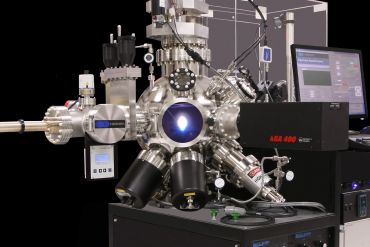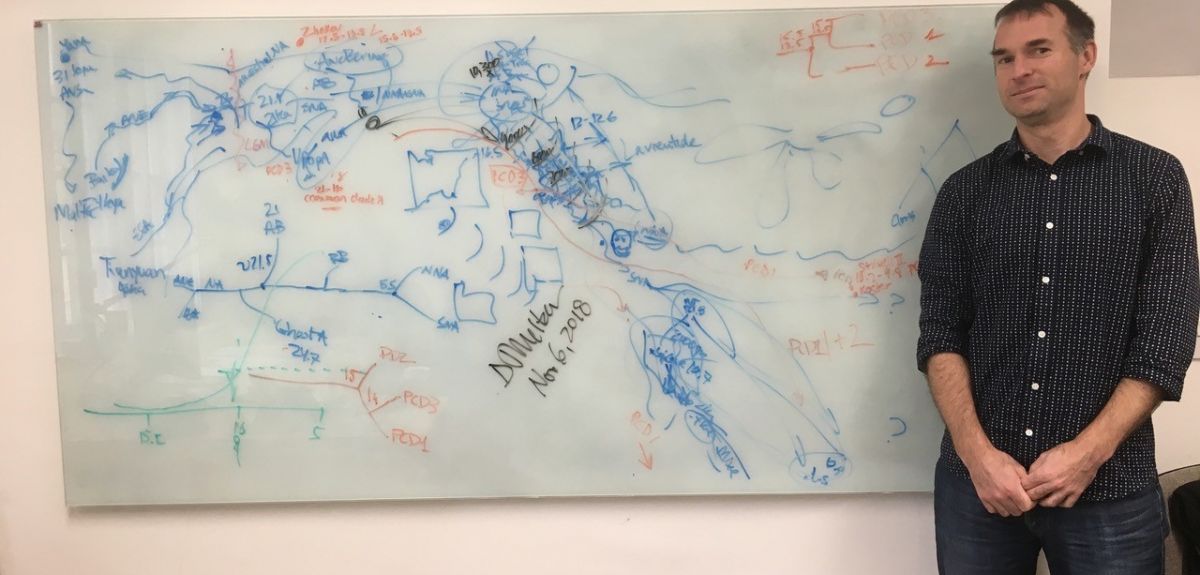Features
Professor Paolo G. Radaelli
Could rust be the secret to next-gen computing technology? Current silicon-based computing technology is incredibly energy-inefficient and, by 2030, information and communications technology (ICT) is projected to gobble up more than 20% of the global electricity production[1].
After the end of the pandemic, climate change is likely to resume its position as the number one challenge for humanity and finding ways decarbonise tech is an obvious target for energy savings.
Professor Paolo Radaelli from Oxford’s Department of Physics, working with Diamond Light Source, has been leading research into silicon alternatives and his group’s surprising findings are published tomorrow in Nature [4 Feb] but online today.
So just how energy-inefficient are computers? Well, the human brain uses approximately a millionth of the energy required by a computer to perform the same operation. To put that in context, the human brain uses about 12 watts of power, while an equivalent computer would use 12 megawatts: the output of a small power station. However, because of its immense success and ubiquitous nature, it is very difficult to replace silicon technology.
The human brain uses about 12 watts of power, while an equivalent computer would use 12 megawatts: the output of a small power station
The promise of oxide electronics
Researchers have been working for a long time on alternative technologies which might afford greater efficiency. Oxides of common metals, such as iron and copper, are natural targets for this research – not least because oxides are already a technology staple and are present in silicon-based computers, so there is a high chance of compatibility between the two technologies.
 Credit: Shutterstock.
How realistic are the prospects of using ‘rust’ in super-efficient computers? We are optimistic
Credit: Shutterstock.
How realistic are the prospects of using ‘rust’ in super-efficient computers? We are optimistic
The kinds of bits we are talking about here must be tiny – ten nanometres (ten billionths of a metre, about 20 times the diameter of an atom) is the typical target figure. And it must be robust even when ‘shaken and stirred’. This is very challenging, because the risk of them being simply dissipated away is very high when the bit is small. One possible solution came from the most unlikely of directions: a curious parallel between solid-state physics and cosmology. In fact, the inspiration for this project was set in the form of a challenge: can we replicate cosmic strings in a magnet?
So what are cosmic strings – and do they even exist? Cosmic strings are supposed to be filaments in space, much thinner than an atom but potentially as long as the distance between stars. But do they exist? Certain cosmological theories predict that they could have formed instants after the Big Bang, as the universe was cooling rapidly. Interestingly, once formed, cosmic strings would be stable and would not ‘evaporate’, so astronomers may be able to discover them in the future.
Cosmic strings are supposed to be filaments in space, much thinner than an atom but potentially as long as the distance between stars
But what do cosmic strings have to do with computers? The relevance comes from the fact that the mathematical description of cosmic strings is rather simple, and the same kind of mathematical conditions that favour the formations of strings may be found in many other physical systems, including magnets. It is the beauty of physics: mathematical equations describing the ‘macrocosm’ at parsec scales may also work in the microcosm at nanometre scales. With the challenge set, all that remained to do was to find a suitable magnet. Once again, the candidate turned out to be most unlikely: common rust.
It is the beauty of physics: mathematical equations describing the ‘macrocosm’ at parsec scales may also work in the microcosm at nanometre scales...all that remained was to find a suitable magnet...the candidate turned out to be most unlikely: common rust.
Rust to riches
Iron oxide (chemical formula Fe2O3) is a main constituent of rust. Each iron atom acts as a tiny compass, but this particular form of Fe2O3 is not magnetic in the ordinary sense of attracting and being attracted by other magnets: it is an antiferromagnet, so that half of the Fe compasses point ‘north’ and the other half ‘south’.
Two years ago, working at the Diamond Light Source on samples produced at University of Wisconsin, Madison, our Oxford group had already discovered the magnetic equivalent of cosmic strings in Fe2O3, and imaged them using a powerful X-ray microscope.[2]
 P180 laser MBE
P180 laser MBEFor the paper published today, we extended our collaboration to the National University of Singapore and managed to find the key to create and destroy magnetic merons at will, exploiting the mathematical equivalent of the ‘Big Bang cooling’.
Back to the future
This is undoubtedly fascinating basic research, but how realistic are the prospects of using ‘rust’ in super-efficient computers? We are optimistic. Though very simple in architecture, the Fe2O3-based device, where merons and bimerons were found, already contains all the ingredients to manipulate these tiny bits quickly and efficiently – by flowing a tiny electrical current in an extremely thin metallic ‘overcoat’. Indeed, controlling and observing the movement of merons and bimerons in real time is the goal of a future X-ray microscopy experiment, currently in the planning phase.
How realistic are the prospects of using ‘rust’ in super-efficient computers? We are optimistic.
When moving from basic to applied research, cost and compatibility considerations are also of paramount importance. Iron oxide itself is extremely abundant and cheap, but the fabrication techniques employed by colleagues at Singapore and Madison are rather complex and require atomic-scale control. Here again, we are optimistic. Very recently, they demonstrated that is possible to ‘peel off’ a thin layer of oxide from its growth medium and stick it almost anywhere, its properties being largely unaffected. Next steps? Design and fabrication of proof-of-principle devices based on ‘cosmic strings’ to follow in short order…
Oxford study shows deaths of environmental activists affect companies' share prices.
More environmental activists have been killed since 2002 than UK soldiers in war zones. But, the truth is, murder is very bad for business, according to new research from an international team including Oxford economics professor Nathaniel Lane, which shows financiers steer clear of firms linked to deaths.
More environmental activists have been killed since 2002 than UK soldiers in war zones. But, the truth is, murder is very bad for business, according to new research from Oxford, which shows financiers steer clear of firms linked to deaths
Having studied the impact of more than 350 assassinations over a 20-year period, linked to mining and minerals sector, the researchers have found the murder of activists has had a significantly detrimental effect on the share price and business of multi-nationals which have been ‘named and shamed’, causing multi-million-pound losses.
In the pre-print study, The Value of Names – Civil Society, Information and Governing Multinationals on the Global Periphery, the team argues, ‘The natural resource industry is a stark example of the tension between society and multinational power. Home to some of the largest global firms, the sector is a flashpoint across the developing world.’
According to Professor Lane, 'Indeed, the point is that we see that human rights reporting and reporting around these events is impactful. In a realm where there is little formal accountability, the work of journalists and civil society can truly impact a firm’s bottom line.'
In a realm where there is little formal accountability, the work of journalists and civil society can truly impact a firm’s bottom line
Around the world, there has been ‘a rising trend in violence towards environmental activists....Specifically, the killing of activists connected to natural resource activity’. The report focuses on such assassinations in the global mining sector, since it is ‘one of the most deadly for activists’. But it also a sector which involves substantial investment, with many firms traded on international stock markets.
According to the report, ‘First, we consider killings that are publicly reported in media or human rights campaigns. Second, we consider events where reporting connects a victim (or victims) to local mining and mineral extraction activity. Third, we then code the location where the death occurred. Fourth, we code the mining companies or projects named (if any) in relation to the event.’
The team says, ‘Our study estimates how publicity surrounding activist assassinations impacts the stock prices of multinationals. Specifically, the mining companies—and their operations—named in international media coverage of these events....
‘Doing so allows us to explore how markets respond to news of violent events surrounding their operations.’
The researchers look at the share prices of companies ‘named’ in human rights’ reporting and international news coverage, without any judgement on the accusations. The examine how firms performed relative to their normal market performance, and also looked at how such corporations fare compared with companies which have not been connected in adverse publicity.
The report reveals, ‘On days leading up to assassinations, we find no evidence of abnormal returns for these companies. Importantly, after the event, we see significant, negative abnormal returns for “named” firms. Significant negative effects appear the day after a killing, and grow steadily for up to ten days after.’
On days leading up to assassinations, we find no evidence of abnormal returns for these companies. Importantly, after the event, we see significant, negative abnormal returns for “named” firms. Significant negative effects appear the day after a killing, and grow steadily for up to ten days after
The involvement of the media and their role in publicising events is key to the public scrutiny of firms and negative publicity once acquired can have a long lasting impact, ‘Companies named in news of assassinations have significant, negative abnormal returns directly following the assassination date–effects which accumulate through time.’
In busy news periods, the researchers found, the impact was not as great. But investors clearly take a close interest in events, ‘Our work suggests that the tools of civil society may help diminish returns to corporate misbehaviour in the developing world.’
The report shows that companies connected to events through publicity were estimated to see their market capitalisation fall by as much as $100 million
The report shows that companies connected to events through publicity were estimated to see their market capitalisation fall by as much as $100 million. The report states, ‘The informational strategies of international civil society impacts the bottom line of multinationals connected to the killing of activists.’
The researchers compared the impact on companies operating in the same vicinity and those which have been explicitly ‘named and shamed’, ‘We find that firms and operations in the vicinity event—though not named in media—are not penalised, relative to those whose operations are specifically named in publicity.’
Research has already been published, showing that ‘markets’ react negatively to bad publicity surrounding businesses. Fraud, insider dealing, environmental, social and governance issues have all been shown to be bad for business.
The researchers believe this is the first time that assassination has been directly linked with negative financial impacts
But the researchers believe this is the first time that assassination has been directly linked with negative financial impacts, ‘To the best of our knowledge, this is the first empirical study that shows that international stock markets react—dare we say penalise—companies operating in association with high profile human rights abuses. In our case, mining companies operating proximate to assassinations of civil society activists...
‘Though preliminary, our findings hint that the publicity strategies of human rights groups, which organise around and place a spotlight on such high-profile episodes, may have some bite. Specifically, by revealing information to international markets. Even where formal justice is rare, these strategies may nevertheless have impact.’
The report concludes, ‘Our findings show that informational campaigns by civil society have in fact an impact on multinational corporations and being linked to human rights abuses can significantly influence an associated companies’ stock market value.’
Dr Tessa Roynon
The US Capitol in Washington DC has been much in the public eye in recent weeks. Whether stormed by President Trump supporters on 6 January, or as the ‘hallowed ground’ that formed the backdrop to President Biden’s inauguration two weeks later, the gleaming perfection of its neoclassical architecture is an unquestioned part of its iconic status.
By contrast, in The Classical Tradition in Modern American Fiction, I take a more quizzical and, at times, sceptical approach to the American love affair with ancient Greece and Rome - and a long, hard look at American novelists’ predilection for classical allusion.
 It asks what is at stake when seven key fiction writers of the 20th/21st centuries: Willa Cather, F. Scott Fitzgerald, William Faulkner, Ralph Ellison, Toni Morrison, Philip Roth, and Marilynne Robinson, refer to the work of Aeschylus, or Homer, or Virgil, or Ovid, in their explorations of modern identity and experience.
It asks what is at stake when seven key fiction writers of the 20th/21st centuries: Willa Cather, F. Scott Fitzgerald, William Faulkner, Ralph Ellison, Toni Morrison, Philip Roth, and Marilynne Robinson, refer to the work of Aeschylus, or Homer, or Virgil, or Ovid, in their explorations of modern identity and experience.
We tend to be far too reverential when faced with allusions to Greek and Roman literature...We tend to assume that such references bestow an immediate and universal authority...We are unthinkingly impressed
The project grew out of my perception, as a reader and a teacher, that we tend to be far too reverential when faced with allusions to Greek and Roman literature, myth, history or visual art. We tend to assume that such references bestow an immediate and universal authority on a text. We are unthinkingly impressed.
My own conviction is that we need to pay close attention when modern writers invoke the ancient past, because they often reach for distant heroes and stories in order to discuss some of the most pressing ideological issues of their (and our) times.
F. Scott Fitzgerald, for example, is obsessed in his fiction with a decadent and ultimately fallen ancient Rome, and he uses this motif to bolster a nativist and anti-immigrant conception of Americanness.
Willa Cather, in Sapphira and the Slave Girl, added many of her classical allusions and framing devices in a very late re-drafting stage - almost as an afterthought, she distorts the realities of slavery and racial injustice through deploying ‘Old Southern’ nostalgic and heroic tradition.
And Philip Roth disguises a visceral misogyny as ‘masculinity’, in his much-feted novel The Human Stain, through the repeated association between his protagonist, Coleman Silk, and Zeus. In Ovid’s Metamorphoses, which Roth frequently invokes, Zeus is a voracious rapist, but Roth attempts to use him to shore up the sense of Coleman as virile hero.
Why do we tend to be such un-alert or acquiescent readers when it comes to antiquity?...we do not study Latin, Greek, or classical civilization at school
Why do we tend to be such un-alert or acquiescent readers when it comes to antiquity? One reason is that nearly all of us are hazy on the details, because we do not study Latin, Greek, or classical civilization at school. A working knowledge of the classical tradition appears now, for the most part, the preserve of an elite minority. If we are not exactly sure who Trimalchio, Hector or Leda is, when these canonical American writers call them up, we are most likely to nod our heads nervously and move quickly on.
The Classical Tradition in Modern American Fiction sets out to counter this process by insisting that the classical past is accessible to all. Complete with its own glossary of every classical name and concept discussed, as well as a guide to the best among the numerous online-resources, it is underpinned by my sincere conviction that all we need to do, when faced with an unfamiliar Greek or Roman term, is the blindingly-obvious: ‘look it up’.
My conviction is deeply-held for two reasons. First, in teaching these authors to my students over the years, I realised nearly all of them felt excluded from the entirety of classical culture. They needed encouragement to look things up but their confidence grew when they did. Second, I was inspired by my research into these each of these writers’ intellectual formation.
All we need to do, when faced with an unfamiliar Greek or Roman term, is the blindingly-obvious: ‘look it up’
In order to understand how they encountered the ancient world, I consulted archives and prior scholarship to understand how and where each studied, how they accessed the classical tradition, what they had read and what they thought about the reading that they had done.
Their contrasting backgrounds and experiences are striking. In the 1890s, Willa Cather studied Latin and Greek to a high level at the University of Nebraska in Lincoln. Philip Roth was highly-educated, including undertaking graduate studies at Chicago, but he never studied the classical languages. Marilynne Robinson has a PhD in English, but studied Latin at high school. Toni Morrison was a Classics minor at Howard. Meanwhile, neither Fitzgerald, Faulkner nor Ellison even completed their undergraduate degrees.
The time period which my chosen authors span, Cather was born in 1873, and Robinson (the only one still living) was born in 1943, encompasses a series of different eras in which classical traditions were variously significant: fin-de-siecle decadence, modernism, liberal humanism, the Great Books tradition and the culture wars of the 1980s. Yet, despite these novelists’ widely diverging contexts, and their widely diverging levels of formal education, they have in common an unqualified passion for reading, and a voracious auto-didacticism.
For me, encountering first-hand the annotations Ralph Ellison made, very often about African American life - in the margins of his translations of Aeschylus, was an unforgettable thrill. Ellison, born in 1913 in Oklahoma City, was so impoverished when he began his undergraduate degree at the Tuskegee Institute in Alabama that he rode ‘hobo’ on trains through the 1930s’ Deep South, to get there. His commitment to his own education, the extraordinary number of books he read, in numerous fields and his stalwart belief in the significance of the classical tradition to his own and to black American life, is a humbling and inspiring example I shall never forget.
Dr Roynon is a Senior Research Fellow at Oxford's Rothermere American Institute.
The RAI is hosting a webinar book launch on 11 February to which all are welcome.
Register in advance at this link: https://zoom.us/webinar/register/WN_1wCpXBqbRa-w7NkDdwSgvA
The evolutionary biologist Olivia Judson wrote, ‘The battle of the sexes is an eternal war.’
Males and females not only behave differently in terms of sex, they are evolutionarily programmed to do so, according to a new study from Oxford, which found sex-specific signals affect behaviour.
Males and females not only behave differently in terms of sex, they are evolutionarily programmed to do so
The new study from Oxford’s Goodwin group from the Department of Physiology, Anatomy and Genetics says, despite sharing very similar genome and nervous system, males and females ‘differ profoundly in reproductive investments and require distinct behavioural, morphological, and physiological adaptations’.
The team argues, ‘In most animal species, the costs associated with reproduction differ between the sexes: females often benefit most from producing high-quality offspring, while males often benefit from mating with as many females as possible. As a result, males and females have evolved profoundly different adaptations to suit their own reproductive needs.’
Males and females have evolved profoundly different adaptations to suit their own reproductive needs
The question for the researchers was: how does selection act on the nervous system to produce adaptive sex-differences in behaviour within the bounds set by physical constraints, including both size and energy, and a largely shared genome?
Today’s study offers a solution to this long-standing question by uncovering a novel circuit architecture principle which allows deployment of completely different behavioural repertoires in males and females, with minimal circuit changes.
The research team, led by Dr Tetsuya Nojima and Dr Annika Rings, found that the nervous system of vinegar flies, Drosophila melanogaster, produced differences in behaviour by delivering different information to the sexes.
In the vinegar fly, males compete for a mate through courtship displays; thus, the ability to chase other flies is adaptive to males, but of little use to females. A female’s investment is focused on the success of their offspring; thus, the ability to choose the best sites to lay eggs is adaptive to females.
When investigating the different role of only four neurons clustered in pairs in each hemisphere of the central brain of both male and female flies, the researchers found the sex differences in their neuronal connectivity reconfigures circuit logic in a sex-specific manner. In essence, males received visual inputs and females received primarily olfactory (odour) inputs. Importantly, the team demonstrated that this dimorphism leads to sex-specific behavioural roles for these neurons: visually guided courtship pursuit in males and communal egg-laying in females.
In essence, males received visual inputs and females received primarily olfactory (odour) inputs
These small changes in connectivity between the sexes allowed for the performance of sex-specific adaptive behaviour most suited to these reproductive needs through minimal modifications of shared neuronal networks. This circuit principle may increase the evolvability of brain circuitry, as sexual circuits become less constrained by different optima in male and females.
And it works, the study says, ‘Ultimately, these circuit reconfigurations lead to the same end result—an increase in reproductive success.
'Our findings suggest a flexible strategy used to structure the nervous system, where relatively minor modifications in neuronal networks allow each sex to react to their surroundings in a sex-appropriate manner.'
Furthermore, this is the first time a firm link between sex-specific differences in neuronal networks have been explicitly linked to behaviour.
According to Professor Stephen Goodwin, 'Previous high-profile papers in the field have suggested that sex-specific differences in higher-order processing of sensory information could lead to sex-specific behaviours; however, those experiments remained exclusively at the level of differences in neuroanatomy and physiology without any demonstrable link to behaviour. I think we have gone further as we have linked higher-order sexually dimorphic anatomical inputs, with sex-specific physiology and sex-specific behavioural roles.'
We have linked higher-order sexually dimorphic anatomical inputs, with sex-specific physiology and sex-specific behavioural roles
Professor Stephen Goodwin
The researchers maintain ‘evolutionary forces’ have driven these adaptations, ‘Drosophila, males compete for a mate through courtship displays, while a female’s investment is focused on the success of their offspring.’
They conclude, ‘In this study, we have shown how a sex-specific switch between visual and olfactory inputs underlies adaptive sex differences in behaviour and provides insight on how similar mechanisms maybe implemented in the brains of other sexually-dimorphic species.’
The full paper, A sex-specific switch between visual and olfactory inputs underlies adaptive sex differences in behaviour, joint-first authored by Dr Tetsuya Nojima and Dr Annika Rings, is available to read in Current Biology.
Twenty three thousand years ago, canines travelled to the New World with the First Americans
When President Biden took up residence last week in the White House, Major and Champ became the latest dogs in a long history, to follow their people on an American journey. Research published this week reveals that the relationship between not just the first Americans’ but everyone’s best friend was deeper than previously thought – 23,000 years’ deep, in fact.
According to the new research, from an international team of archaeologists and geneticists including Oxford’s Professor Greger Larson, dogs travelled alongside the first people who made the journey across the Bering straits to the Americas.
The research reveals dogs spread throughout the Americas, along with people, and developed completely separately to their European cousins
The research reveals dogs then spread throughout the Americas, along with people, and developed completely separately to their European cousins. When the first European settlers arrived across the Atlantic, bringing their dogs of course, the indigenous American dogs were genetically distinct. And, as with many indigenous peoples – the indigenous American dogs all-but died out, when confronted with European people and dogs.
Today, there is little trace left of the animals who braved the long journey during the last Ice Age, to accompany their fellow human travellers into a new land.
As with many indigenous peoples – the indigenous American dogs all-but died out, when confronted with European people and dogs
According to the study, ‘The first people to enter the Americas likely did so with their dogs. The subsequent geographic dispersal and genetic divergences within each population suggest that where people went, dogs went too.’
Professor Larson says, ‘We found a very strong correlation between the pattern of ancient dogs’ genetic diversification and the genetic signatures of early Americans. The similarities between the two species is striking and suggests the shared pattern is not a coincidence.’
He adds, ‘We knew dogs were the oldest domesticated species, and these findings now suggest that the initial process of domestication began around 23,000 years ago in north-east Siberia. From there, people and dogs moved together east into the Americas, south towards east Asia, and west towards Europe and Africa.'
We knew dogs were the oldest domesticated species, and these findings now suggest that the initial process of domestication began around 23,000 years ago in north-east Siberia
Professor Greger Larson
According to this week’s report, ‘The convergence of the early genetic histories of people and dogs in Siberia and Beringia suggests that this may be the region where humans and wolves first entered into a domestic relationship...this process likely began between 26,000 and 19,000 years ago, which precedes evidence for the first unequivocal dogs in the archaeological record by as much as 11,000.’
This is important research, not only for what it says about dogs’ arrival in the Americas, but also for what it reveals about people. And the report states, ‘Since their emergence from wolves, dogs have played a wide variety of roles within human societies, many of which are specifically tied to the lifeways of cultures worldwide. Future archaeological research combined with numerous scientific techniques, will no doubt reveal how the emerging mutual relationship between people and dogs led to their successful dispersal across the globe.’
This is not the first time Professor Larson has produced research about ancient dogs (and Dire Wolves). Does this new study reveal a preference for canines?
Imagine what society would be like if we had not formed mutually interdependent relationships with so many other domestic plants and animals. And it all started with dogs
Professor Larson
‘I grew up with dogs, and I always interact with them when they walk by’ he says. ‘Dogs were the first species to enter into a mutualistic relationship with us. It was a key shift in the evolution of our species...It is amazing how much everything began to change after that.
'For the vast majority of our species’ history we travelled alone and made a tiny impression on the earth’s ecology. Now there are eight billion of us and we depend on a range of domestic plants and animals for the maintenance of our huge global population. Imagine what society would be like if we had not formed mutually interdependent relationships with so many other domestic plants and animals. And it all started with dogs.’
The article in PNAS is available here: https://www.pnas.org/cgi/doi/10.1073/pnas.2010083118
- ‹ previous
- 26 of 248
- next ›





 The Oxford students at the forefront of the fight against microbial resistance
The Oxford students at the forefront of the fight against microbial resistance  The hidden cost of AI: In conversation with Professor Mark Graham
The hidden cost of AI: In conversation with Professor Mark Graham  Astrophoria Foundation Year: Dr Jo Begbie reflects on the programme’s first year
Astrophoria Foundation Year: Dr Jo Begbie reflects on the programme’s first year World Malaria Day 2024: an interview with Professor Philippe Guerin
World Malaria Day 2024: an interview with Professor Philippe Guerin From health policies to clinical practice, research on mental and brain health influences many areas of public life
From health policies to clinical practice, research on mental and brain health influences many areas of public life From research to action: How the Young Lives project is helping to protect girls from child marriage
From research to action: How the Young Lives project is helping to protect girls from child marriage  Can we truly align AI with human values? - Q&A with Brian Christian
Can we truly align AI with human values? - Q&A with Brian Christian  Entering the quantum era
Entering the quantum era Can AI be a force for inclusion?
Can AI be a force for inclusion?